PSA
We admit: it was all our fault. We brought about the looming AI doomsday. You know all those “I am not a robot” CAPTCHA verification nuisances where you have to identify motorcycles or lampposts or whatnot? Unfortunately, what we have really been doing is training AI. It’s all our fault!
So, to help save humanity, Rajeev Basu has created a “public service videogame” called Confuse-a-Bot. The premise is, says Basu:
AI is only as good as its datasets. CONFUSE A BOT is a “public service videogame” that invites players to verify images incorrectly, to confuse bots, and help save humanity from an AI apocalypse.
How the game works:
– The game pulls in images from the Internet, and asks players to verify them.
– Players verify images incorrectly. The more they do, the more points they get.
– The game automatically re-releases the incorrectly verified images online, for AI to scrape and absorb, thereby helping save humanity from an AI takeover. It’s that easy!
The twist is that all the incorrect answers will be cheese.
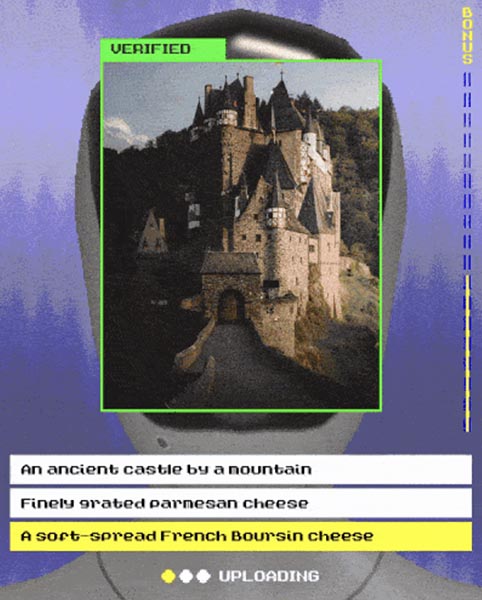
And on the plus side you get to learn about cheese. Oh, and save humanity.
Confuse A Bot – Official Game Trailer from Rajeev Basu on Vimeo.
Bugged
July 3 is the 140th anniversary of the birth of Franz Kafka (you do have that on your calendar, right, or should we send you a calendar invite?). To commemorate the occasion, Israeli type designer, typographer, and Kafka enthusiast Oded Ezer has embarked on a unique project: “The Samsa Enigma.” Says Print magazine:
His homage to the great Kafka involves the creation of 24 covers for the unpublished books of Gregor Samsa, the main fictional character, who mysteriously transforms overnight into a cockroach in Kafka’s classic 1912 story, “The Metamorphosis.”
(We nerdily point out that in the story, he is not identified specifically as a cockroach, but rather a “gigantic insect” or “horrible vermin,” depending on which translation you are using. Anyway, we continue…)
The idea behind the project was that Gregor Samsa was a real person who wrote 24 unpublished books before taking his own life. Ezer’s premise is that Kafka was acquainted with these books used their titles to create the opening paragraph of “The Metamorphosis.”
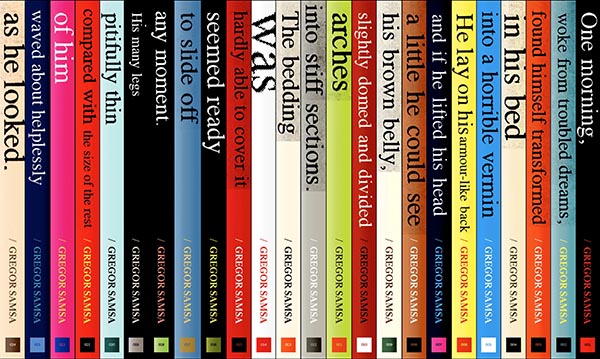
No wonder they were never published. Would you read a book called “into stiff sections”?
Print’s Steven Heller interviews Ezer:
What’s new for me in this project is that I took on the task of illustrating the images myself for the first time. Typically, my work focuses on typography, but this time I decided to incorporate unusual drawings of creatures. Interestingly, these drawings still have a strong typographic influence. Even when I’m drawing, I approach it systematically, similar to how I design a font with different letters and symbols. Additionally, I aim to give these drawings an iconic character, akin to the ambition I have when designing letters. So, in a somewhat contradictory manner, this project was approached from the perspective of a font designer rather than an illustrator.
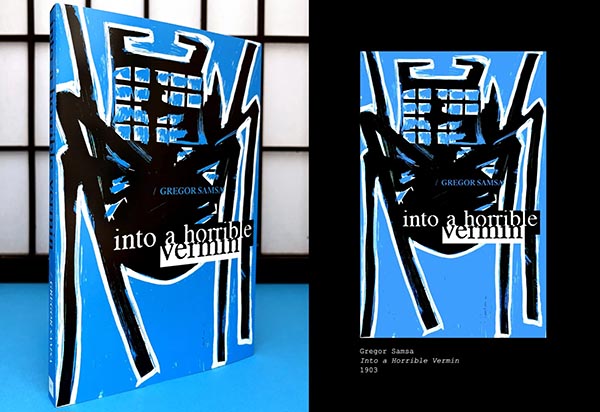
Now, wouldn’t it be great if someone took on the task of actually writing these books. Hmm…
Blanket Statement
For those of you who fondly remember the original Mac OS, celebrate that old tech with this Mac OS blanket, created by Throwboy, a Seattle-based company that produces throw pillows and blankets based on 1980s-era technology. Says Ars Technica:
To create the Classic Desktop Knit Cotton Blanket, [founder and CEO Roberto] Hoyos says he teamed up with New York-based Mineola Knitting Co. “They use recycled cotton and poly materials to create the knitted patterns you see in the Classic Desktop Knit Blanket. The result is a soft, durable blanket that has a nice weight and quality feel,” he says.
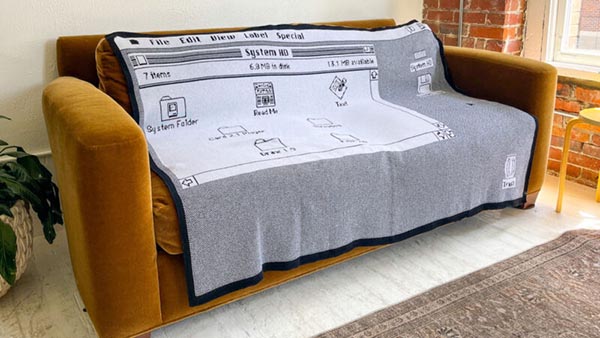
The company seeks to tap into 68K Mac nostalgia, but Ars Technica nerdily points out that “It looks like System 7 to us, based on the presence of the Balloon Help icon.” Picky picky.
It’s a steal at $185.
Now, can they produce it digitally?
“Seven Days” in May
From WhatTheyThink contributor Mark V (heir to the throne of Mark IV), a look behind the scenes of Seven Days, a Vermont-based weekly newspaper (yes, a weekly newspaper that still exists!).
Sollberger spent a Monday and Tuesday at Seven Days’ Burlington office, talking to writers, designers, proofreaders and editors about the process of making the weekly newspaper. Then she crossed the border into Canada with publisher and editor in chief Paula Routly. The two arrived in time to watch the fast-paced factory print 35,000 copies of the paper late on a Tuesday night. They returned to Burlington at 3 a.m. on Wednesday morning — just a few hours before a truck from the press pulled up to the Seven Days loading dock, full of freshly printed copies to be distributed across the state.
Livin’ La Vida ’Loga
Every once in a while, ’round about these parts, we mention David Sax’s 2016 book The Revenge of Analog, about the resurgence of non-digital technologies, and how as our word has become more digitized, “the more we seek out analog alternatives as a balance or a different way of engaging with the world.” (And it’s not just older folks, but younger generations in particular who are gravitating to things like film cameras and vinyl records.)
This week, the Washington Post offered a few tips for those looking to live the analog life, in particular printed books:
A reader of strictly printed books will argue that nothing compares to the feeling of a physical book in one’s hands. You can dog-ear pages,
No, you really can’t, at least not in our books.
fold back the cover,
You break our spine, we’ll break yours.
gauge how far along you are and fill up your bookshelves. In fact, Gen Z readers frequent libraries and generally prefer physical books to e-books.
Not just books, but magazines, as well.
Magazines are also sticking around; in the past two years, nearly 200 new magazines have launched. Part of the appeal is the lasting impact of magazines. Diamond found old issues of Popeye, a Japanese men’s magazine, at a vintage store. “Some Japanese men’s magazine from 1984 somehow can influence me in 2023,” he said.
OK, TMI.
Full-bleed photos, varied fonts and colorful illustrations contribute to a different experience in print than on a screen. Pages from magazines can be used for creating vision boards and collaging on large pieces of poster board or in a journal. There’s also creative value in the tactile nature of the magazine. “Physical things have a lot more decisions that had to be made to create them,” Goodspeed said. “There’s a real difference between reading Interview magazine, which is huge, and reading Reader’s Digest, which is small.”
The article also includes things like pens and stationery, writing physical letters, and sending postcards.
Cat-astrophe Averted
Another public service announcement: do not include cats in your recycling; there is a separate bin for them. (We’re kidding.) Anyway, a happy story about a kitten who was rescued from a recycling container. From ITV:
A tiny kitten has survived being crushed in a recycling container, after what an RSPCA officer has described as one of the ‘most extraordinary rescues’ they’ve ever taken part in.
‘Biff’ the kitten who was just 2-weeks-old, was pulled free after a two-day operation in Liverpool.
It’s thought the mum had gone inside to give birth to her baby and then become trapped as it got continually filled with more and more cardboard.
The RSPCA were called after meowing noises had been heard coming from inside the container.
When RSPCA inspector Vicki Brooks arrived on the scene on 30 May, the face of the adult cat was peeking out of a tiny hole at one end of the container and the faint meowing of a kitten - who is now being hand-reared at the RSPCA’s Wirral and Chester branch care and named Biff - could be heard behind her.
It’s thought mother and son may have been stuck inside the unit in sweltering heat without food or water for several days.
A compactor which dropped the cardboard in and flattened it with a metal plate was separated from the back of the container, and the inspector, along with staff from Makro, then spent five hours painstakingly removing pieces of cardboard by hand in an attempt to reach the cats.
...“We’re incredibly grateful to Thomas Cheeseman and his colleagues at Makro for the incredible support they gave us from the start of the operation until the finish - their care and compassion was heartwarming - as well the container company, DS Smith, who sent a driver out of hours to move the compactor.”
So all’s well that ends well.
Drive-By Messaging
They refer to it as skywriting, but much lower. “Maker” Ryder Damen has kitted out his pickup truck so that it functions as a giant dot matrix printer. Via Tom’s Hardware:
The printing process works by dropping splotches of water onto the road while the truck is driven. The water is dropped carefully to shape letters and form custom messages. The system is mounted to the back of the truck and controlled from inside the cabin using a web interface. As a message is parsed, a series of tubes direct water into position and activate precisely to create shapes much like a dot matrix printer.
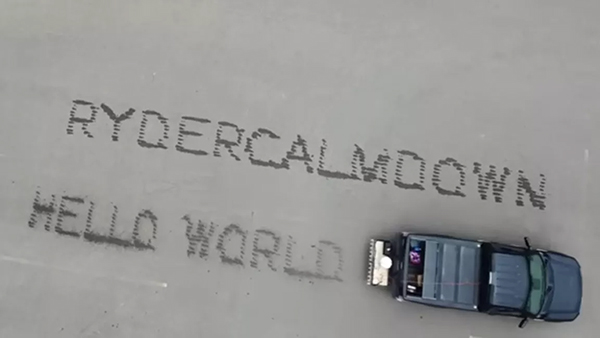
The Raspberry Pi is responsible for running the web interface, accepting user input for new messages and sending the command to trigger the water-based printing system. In this case, Ryder has opted to use a Raspberry Pi 4 but you could get away with using an older model like a Raspberry Pi 3 B+ or maybe even a Raspberry Pi Zero.
Maybe even. This is brilliant. Check it out:
Netfood
Here’s one way streaming services can compensate for declining subscriptions: open a restaurant, which is exactly what Netflix has done, launching a pop-up in LA to tie in with its cooking shows. Via Food & Wine:
Oh, don’t even get us started…
which opens in Los Angeles on June 30, will showcase the talents of some of its most popular chefs, including Dominique Crenn (from Chef’s Table), Nadiya Hussain (Nadiya Bakes), Ann Kim (Chef's Table: Pizza), Rodney Scott (Chef’s Table: BBQ), Curtis Stone (Iron Chef: Quest for an Iron Legend), Jacques Torres (Nailed It!), Ming Tsai (Iron Chef: Quest for an Iron Legend), and Andrew Zimmern (Iron Chef: Quest for an Iron Legend).
If you’re in the LA area:
Netflix Bites will be open for a limited time at the Short Stories Hotel in Los Angeles. It is currently accepting reservations through Resy, and will be open Monday through Friday from 5 p.m. to 10 p.m., and from 10 a.m. to 2 p.m. on Saturday and Sunday.
We’re waiting for the Black Mirror-themed restaurant…
Old Media
Do you (or, more likely, your forebears) have “old media” hanging around—that is, old family movies on Super 8, VHS, or DVD (wait…DVDs are old media?!)? What about pictures or other files on floppy disks or CDs? You could easily spend a ton getting these items digitized, or at least converted into file formats readable by today’s devices. However, the Los Angeles Public Library has introduced the DIY Memory Lab, a maker space where library patrons can digitize a wide variety of old tech, including:
- Documents
- Photos, slides, negatives
- Super 8 and 8mm film (picture only, no audio)
- Compact audio cassette
- CD and DVD
- DV and MiniDV (SP)
- 3.5” inch floppy disks
- Minidisc
- Reel to reel audio tape
- VHS (SP and EP)
- Vinyl record (LP and 45)
To use the DIY Memory Lab, patrons must have a Los Angeles Public Library card in good standing, attend an online orientation, read and agree to Octavia Lab policies, sign a release form, and make a reservation.
It helps to live in LA, of course, but public libraries have been adding all kinds of maker spaces and offering classes, so if you have a burning need to digitize old content, it might be worth a visit to your public library’s website.
And then once you get all your old content converted, your grandchildren can repeat the process when today’s tech is incompatible with whatever will exist in the future.
Graphene Power
Was it a good week for graphene news? It’s always a good week for graphene news! Lyten launches a new automated manufacturing plant to produce graphene-enhanced lithium-sulfur batteries. From (who else?) Graphene-Info:
The Lyten battery pilot line will produce Lithium-Sulfur cells in a range of pouch and cylindrical form factors to support a variety of customer requirements and allow Lyten to further develop manufacturing equipment capabilities for scaled Lithium-Sulfur cell production. The pilot line will deliver cells that exceed conventional Nickel-Cobalt-Manganese (NMC) lithium-ion battery gravimetric energy densities.
The key aspects is improved energy density.
Celina Mikolajczak, Lyten’s Chief Battery Technical Officer, added: “Lithium-Sulfur is the battery chemistry that has the potential to electrify everything. A projected 50 percent lower cost bill of materials compared to conventional lithium-ion chemistries will enable significantly lower-cost automotive battery packs, making an all-electric automotive fleet economically achievable. The high energy density of the chemistry will make it appealing for application in heavy vehicles such as delivery vans, trucks, buses, and construction equipment, as well as in aviation and satellites. The raw materials for this chemistry are abundant throughout North America favoring a domestic supply chain and domestic manufacturing, supporting a strong American electrification industry.”
Life on Venus?
Of all the planets in the Solar System, one of the most inhospitable is Venus, so it has long been thought that looking for life on Venus would be a non-starter. After all, ground temperatures average 867°F (464°C), so no possibility of liquid water. Sure, it’s cooler off the ground, but the clouds of sulfuric acid aren’t entirely life-promoting. However, new research has revealed that those clouds may not entirely preclude the possibility of harboring come kind of life. Says Science Alert:
Although the chance microbes might thrive in such an environment is slim, it’s plausible enough to warrant considering.
“The clouds can support a biomass that could readily be detectable by future astrobiology-focused space missions from its impact on the atmosphere,” write a team led by molecular biologist William Bains of Cardiff University in the UK and MIT in the US in a paper published in Astrobiology.
“Although we consider the prospects for finding life on Venus to be speculative, they are not absent. The scientific reward from finding life in such an un-Earthlike environment justifies considering how observations and missions should be designed to be capable of detecting life if it is there.”
The idea of life on Venus kicked into high in 2020 when traces of phosphine gas were discovered in Venus’ atmosphere, although the discovery has been heavily debated. Phosphine on Earth has been found in anaerobic (low-oxygen) environments where anaerobic microbes have been found to dwell quite happily. However, volcanos can also produce phosphine.
Another key question is, could the molecules necessary for life exist in sulfuric acid? The Astrobiology paper debates this idea,
Previous research from the team found that sulfuric acid could be used by life as a solvent, but it wouldn’t be life as we know it. One major reason for that is that RNA and DNA are unstable in sulfuric acid. But nucleic bases – the basic building blocks of RNA and DNA – might not be, depending on what they are.
So they put a bunch of nucleic bases in sulfuric acid and results were mixed.
Adenine, cytosine, guanine, thymine, and uracil remained stable for several weeks at room temperature, between 18 and 21 degrees Celsius, similar to Venusian cloud temperatures.
So did purine and pyrimidine, as well as a compound called 2,6-diaminopurine, which is used as a genetic base substitute for adenine by some viruses. This means that, theoretically, at least, the same nucleic bases could hang around quite happily in the sulfuric acid clouds of Venus.
So could sulfuric acid play the role that water plays on Earth? It’s theoretically possible.
“Terrestrial life cannot survive in Venus’ clouds. We encourage others to consider Venus as a place where some highly non-terrestrial life just might live and to explore what that life might be and how we might economically search for it.”
After all, Venus and Earth have been called sister planets in that they share many similarities, but by some fluke of planetary evolution, Earth is wet and temperate, while Venus is hot and acidic. But, hey, some Felona e Sorona-esque phenomenon may switch their places.
Hopping Mad
Here at WhatTheyThink, our data analysis section is always stressing that we should always “adjust for inflation” when comparing revenues, profits, and other economic data over time. However, at our sister organization, WhatTheyDrink, the stress is on “adjusting for ‘drinkflation,’” which is actually now a thing, at least in the UK. Via CNN:
Brewers in the United Kingdom are cutting the alcohol content — but not the price — of several of their most popular beers in what’s been described as another example of “shrinkflation.”
Shrinkflation—which is not just a British phenomenon—is where food producers and supermarkets reduce the size or quantity of their products without cutting prices.
Greene King, a major UK brewer and pub chain, has cut the ABV, or alcohol content, of its popular Old Speckled Hen pale ale to 4.8% from 5%, a spokesperson for Greene King told CNN.
In March, the country’s oldest brewer, Shepherd Neame, slashed the ABV of its bottled Spitfire and Bishops Finger ales to 4.2% and 5.2% respectively, from 4.5% and 5.4%, a spokesperson said.
There is an underlying reason for this:
Since, under UK law, brewers pay less tax on drinks with a lower alcohol content, the newspaper claimed that the companies had pocketed this saving rather than passing it onto customers through lower prices.
We’re shocked, shocked! And of course this is in response to consumer demand. Of course it is.
The spokesperson for Shepherd Neame told CNN that it had lowered the ABV content of its beers to “expand their appeal” as consumers were “increasingly choosing drinks with a lower alcohol content as part of a healthy lifestyle.”
So we guess just having a separate low-ABV beer is out of the question.
Did anything catch your eye “around the Web” this week? Let us know at [email protected].
This Week in Printing, Publishing, and Media History
June 19
1623: French mathematician and physicist Blaise Pascal born.
1846: The first officially recorded, organized baseball game is played under Alexander Cartwright’s rules on Hoboken, N.J.’s Elysian Fields with the New York Base Ball Club defeating the Knickerbockers 23–1.
1897: American comedian Moe Howard born.
1934: The Communications Act of 1934 establishes the Federal Communications Commission (FCC).
1947: Indian-English novelist and essayist Salman Rushdie born.
1948: English singer-songwriter Nick Drake born.
1978: Garfield, holder of the Guinness World Record for the world’s most widely syndicated comic strip, makes its debut.
2018: The 10,000,000th United States Patent is issued (“Coherent Ladar Using Intra-Pixel Quadrature Detection,” assigned to Raytheon Company).
June 20
1840: Samuel Morse receives the patent for the telegraph, which becomes the dominant communication method. Until...
...1877: Alexander Graham Bell installs the world’s first commercial telephone service in Hamilton, Ontario.
1928: American saxophonist, flute player, and composer Eric Dolphy born.
[year withheld]: Frank Romano born. Shortly thereafter, was visited by three “iMagi” bearing gold from Gutenberg’s goldsmith shop, a line of type from Ottmar Myrrh-genthaler, and he’ll be Frank-incensed if he reads this.
1975: The film Jaws is released in the United States, becoming the highest-grossing film of that time and starting the trend of films known as “summer blockbusters.”
2003: The Wikimedia Foundation is founded. The Wikimedia Foundation is a nonprofit charitable organization dedicated to encouraging the growth, development, and distribution of free, multilingual, educational content, and to providing the full content of these wiki-based projects to the public free of charge. Most notably, it operates Wikipedia.
June 21
1903: American caricaturist, painter and illustrator Al Hirschfeld is born.
1905: French philosopher and author Jean-Paul Sartre born.
1944: English singer-songwriter and guitarist Ray Davies born.
1957: American author, illustrator, and creator of the Bloom County comic strip Berkeley Breathed born.
1973: WTF: the Supreme Court hands down the decision in Miller v. California 413 US 15, establishing the Miller test for obscenity in U.S. law.
1978: The original production of Tim Rice and Andrew Lloyd Webber’s musical Evita, based on the life of Eva Perón, opens at the Prince Edward Theatre, London.
June 22
1906: Austrian-born American director, producer, and screenwriter Billy Wilder born.
1969: The Cuyahoga River catches fire in Cleveland, Ohio, drawing national attention to water pollution, and spurring the passing of the Clean Water Act and the creation of the Environmental Protection Agency.
June 23
1860: The United States Congress establishes the Government Printing Office.
1868: Christopher Latham Sholes receives a patent for the "Type-Writer."
1910: French playwright and screenwriter Jean Anouilh born.
1912: English mathematician and computer scientist Alan Turing is born.
1926: The College Board administers the first SAT exam.
1969: IBM announces that it will start pricing its software and services separately from hardware—thus creating the modern software industry.
1991: Sonic the Hedgehog is released to American audiences, then to PAL and Japanese audiences a month later, kickstarting the successful Sonic franchise.
2013: American author and screenwriter Richard Matheson dies (b. 1926).
June 24
1842: American short story writer, essayist, and journalist Ambrose Bierce born.
1930: American businessman, founder of Ziff Davis William Bernard Ziff Jr. born.
1947: Kenneth Arnold makes the first widely reported UFO sighting near Mount Rainier, Wash.
1949: The first television western, Hopalong Cassidy, is aired on NBC starring William Boyd.
1957: In Roth v. United States, the U.S. Supreme Court rules that obscenity is not protected by the First Amendment.
June 25
1848: A photograph of France’s June Days uprising, “Barricades on rue Saint-Maur,” becomes the first photograph used to accompany a newspaper story, launching the practice of photojournalism.
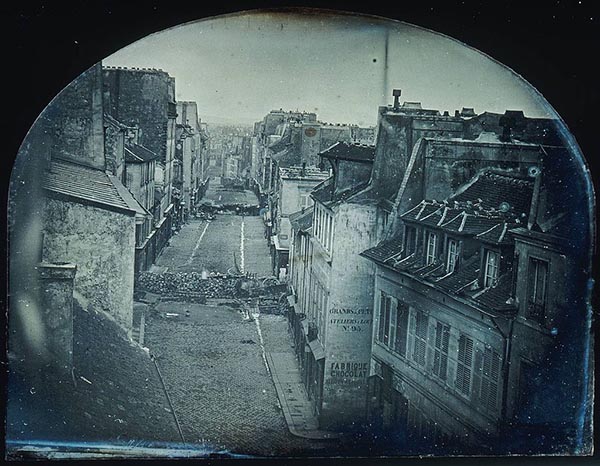
1903: British novelist, essayist, and critic George Orwell born.













